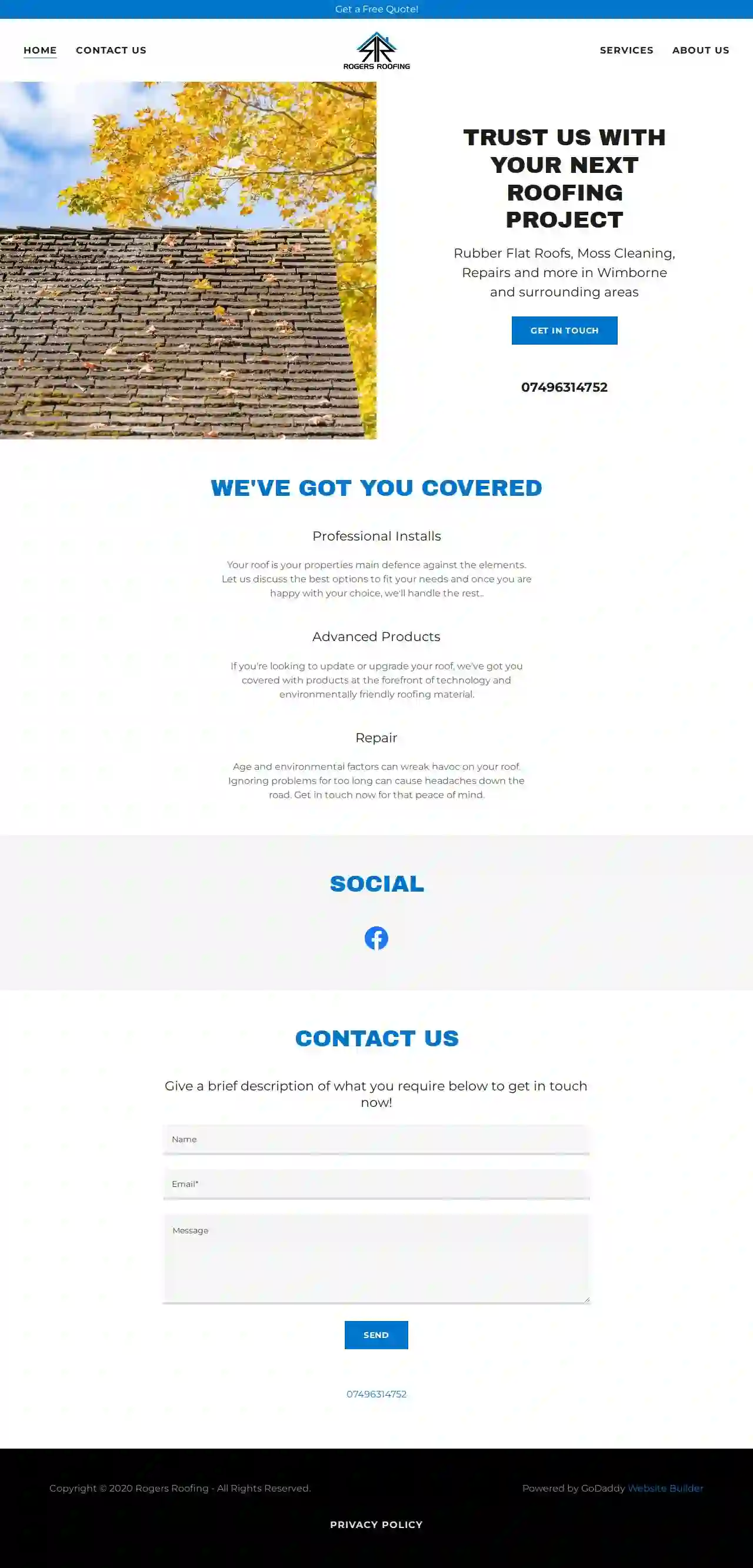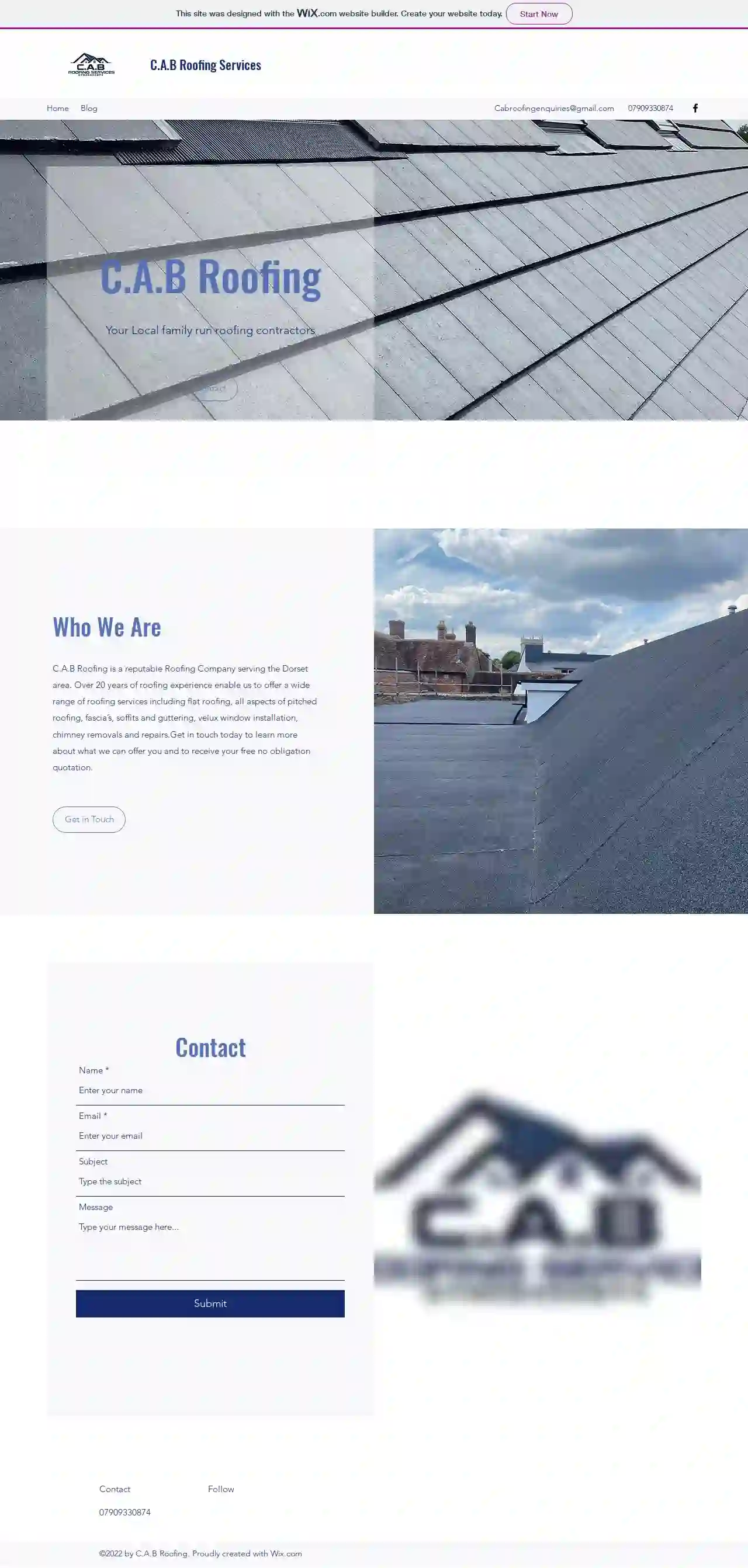Roofing Companies Oakham
Best Roofing Service in Oakham
Get 3 FREE Roofing Company quotes for your project today! Compare profiles, reviews, accreditations, portfolio, etc... and choose the best offer.

Rogers Roofing
51 reviews9 Hayes Lane, Wimborne, BH21 2JA, GBRogers Roofing Solutions is a family-run business with over four generations of roofing experience. Our director, Fraser Rogers, is a Firestone trained EPDM roofer, ensuring you receive the highest quality workmanship and materials. We are committed to delivering exceptional service and ensuring every customer is completely satisfied. We offer a range of roofing services, including Firestone RubberCover installations, moss cleaning, and repairs. Our team utilizes traditional methods for moss cleaning, ensuring the longevity and beauty of your roof. At Rogers Roofing, we prioritize your needs and strive to save you both time and money. All new installations come with a 10-year guarantee, and repairs are backed by a 12-month guarantee. Contact us today for a free quote or to discuss your roofing requirements.
- Services
- Why Us?
- Our Team
- Gallery
Get Quote
Bluecord Roofing & Cladding Ltd
5 Yeomans Way, Bournemouth, BH8 0BL, GBWith over 30 years in the business of roofing and bespoke aluminium fabrications we offer the combination of excellent workmanship and very keen prices, a boast that can be backed up by the testimony of many satisfied customers. We have a wide portfolio within the commercial and residential sectors. We are a Bournemouth based company and we constantly work all over the south of England. All of our operatives are fully trained to NVQ level and very experienced, some with over 20 years service. As a company we take safety very seriously and we are accredited SSIP Worksafe Contractors. Thanks to our customers we are proud to support the following charities
- Services
- Why Us?
- Accreditations
- Gallery
Get Quote
Warkton Roofing Co Ltd
3.737 reviewsTrafalgar Road, Warkton House, Kettering, NN16 8DB, GBWarkton Roofing is a family-run roofing company with over 45 years of experience based in Kettering, Northamptonshire. We are a leading roofing contractor and merchant, specialising in all aspects of roofing for both residential and commercial properties throughout Northamptonshire and the surrounding counties. Our team of highly-skilled roofing operatives is dedicated to providing a comprehensive range of roofing services, ensuring a truly elite and personal service for all our clients. We pride ourselves on our commitment to health and safety, offering a 10-year guarantee on all jobs. We are fully insured and strive to go the extra mile to exceed your expectations.
- Services
- Why Us?
- Accreditations
- Gallery
Get Quote
AKT Roofing Ltd
4.411 reviewsSouthcote Road, Unit 5 Central Business Park, Bournemouth, BH1 3SJ, GBWelcome to AKT Roofing, Dorset’s Expert Roofers. AKT Roofing Ltd is based in Bournemouth, we undertake all aspects of roofing works across Dorset. From small roof repairs on domestic dwellings to approved roofing systems on commercial properties. Get in touch with us today for a free quote (Terms may apply).
- Services
- Why Us?
- Accreditations
- Testimonials
- Gallery
Get Quote
All Seasons Roof
4.633 reviewsForest Links Road, Ferndown, BH22 9PH, GBAll Seasons Roof is a leading provider of conservatory roofing and insulation solutions, dedicated to transforming outdated conservatories into comfortable and stylish living spaces. We understand that a conservatory can be a valuable addition to your home, but often suffers from extreme temperatures, noise, and condensation. Our team of qualified specialists offers a range of innovative products, including CosyPanels® and lightweight roof tiling, designed to address these common issues. We pride ourselves on providing high-quality, cost-effective solutions with fast track installation, ensuring minimal disruption to your daily life. As a HICS accredited member, we are committed to providing comprehensive protection and peace of mind to our customers throughout the entire process, from initial consultation to after-sales service.
- Services
- Why Us?
- Accreditations
- Testimonials
- Gallery
Get Quote
Imperial Roofing Supplies UK Ltd
528 reviewsUnit 23, Charnwood Edge Business Park, Syston Road, Cossington, LE7 4UZ, GBImperial Roofing Supplies is a family-run, independent roofing supplier based in Syston, Leicester. Established in 1999, we pride ourselves on providing impartial advice based on years of experience in the building industry. Our commitment to service extends to both trade and public customers, offering a wide range of products from leading manufacturers and specialist providers, many of which are exclusive to us. We are proud to be stockists of Index Rinova (overlay felt), a niche product with a 15-year insurance-backed guarantee. Our team of roofing experts has extensive knowledge and experience to guide you through your roofing project, whether it's a refurbishment or a complete new roof. We offer a comprehensive range of products for both flat and pitched roofs, including tiles, slates, reclaimed materials, ventilation, chimney products, timber, and tools. We are dedicated to providing excellent customer service and ensuring you find the right roofing solution for your needs and budget. Visit our trade counter in Syston or call us today for expert advice and competitive prices.
- Services
- Why Us?
- Accreditations
- Our Team
- Testimonials
- Gallery
Get Quote
C.A.B Roofing Services
51 reviewsBourne, GBC.A.B Roofing is a reputable Roofing Company serving the Dorset area. With over 20 years of roofing experience, we are able to offer a wide range of roofing services including flat roofing, all aspects of pitched roofing, fascia’s, soffits and guttering, velux window installation, chimney removals and repairs. Get in touch today to learn more about what we can offer you and to receive your free no obligation quotation.
- Services
- Why Us?
- Gallery
Get Quote
Leicestershire Flat Roofing Limited
Countesthorpe Business Park, Leicester, Unit 1, Countesthorpe, LE8 2AA, GBLeicestershire Flat Roofing Ltd has over 25 years’ experience in all aspects of flat roofing in both the domestic and commercial sectors, nationwide. We pride ourselves in being able to provide and deliver a premium product to suit all budgets and project sizes. Our roofers are highly skilled and competent. They are accredited to install a wide variety of industry leading roofing membranes and systems. The health and safety of our operatives and clients is paramount. We are compliant with health and safety legislation and have received a number of awards for our operative's compliance of sites. We are fully insured with public and employer liability. Our operatives are registered with the CSCS and CPCS. We pride ourselves in being able to provide and deliver a premium product to suit all budgets. The materials we use are of a premium quality and come with either a 10, 15 or 20 year manufacturers guarantee. We also offer 10-year insurance back guarantee. With over 25 years’ experience in the flat roofing industry, Leicestershire flat roofing is highly skilled in single ply roofing systems and built up felt roofing systems. Our innovation, outstanding workmanship and use of the highest quality materials is evidenced by our impressive portfolio of work in both the commercial and domestic sectors and excellent reputation, nationwide. We can provide both labour only and supply and fit service to meet your roofing needs. Leicestershire Flat Roofing have a growing team of highly skilled operatives. We are approved installers of a variety of flat roofing systems and only supply materials that hold manufacturer product warranty. We are fully insured, CITB registered and compliant with health and safety legislation, giving you complete peace of mind.
- Services
- Why Us?
- Accreditations
- Our Team
- Testimonials
- Gallery
Get Quote
BWPS Roofwindows
32 reviews90 High Howe Lane, Bearwood, BH11 9QX, GBBWPS Roof Windows is a family-run business based in Bournemouth, Dorset, specializing in the installation and repair of VELUX roof windows and accessories. With over 30 years of experience, they are the No.1 choice for VELUX window installations on the South Coast, serving customers in Bournemouth, Dorset, Hampshire, and Wiltshire. They pride themselves on delivering a fantastic finish and ensuring customer satisfaction. BWPS is a VELUX Certified Installer and a member of TRUSTMARK and CERTASS, guaranteeing their expertise and commitment to quality. They offer a wide range of VELUX products, from skylights and blinds to shutters and sun tunnels, catering to various needs and preferences. BWPS also provides maintenance and servicing for existing roof windows, ensuring their longevity and optimal performance. Their team is dedicated to providing friendly, efficient, and reliable service, offering free no-obligation quotes and transparent pricing.
- Services
- Why Us?
- Accreditations
- Our Team
- Testimonials
- Gallery
Get Quote
The Flat Roofing Company
4.516 reviewsGBWelcome to The Flat Roofing Company, the go-to experts for all your flat roofing needs. Our knowledgeable and experienced team have the skill necessary to work on buildings of all sizes. Navigation Home About Services Other Services Projects Contact Us 20 Year Warranty All of our work comes with a 20 year Warranty. This will be emailed and a certificate posted to the client upon completion of your project. This is for any sized project from a few metres to a few thousand. For larger projects we will also bring out site technicians from our membrane manufacturer. They will provide assurances of the materials being used and the way it is being installed. Then upon a final assessment they will sign over the warranty. We want you to feel relaxed and assured that our work is to the very highest standard and we pride ourselves of creating long term roofing solutions. Domestic Whether it’s for installation or maintenance, you can count on us to help with your roof at home. Commercial No matter the size of your business, our versatile team can help cater to your flat roof needs. Industrial Our expertise in supplying and maintaining strong and secure flat roofs are ideal for any industrial site.
- Services
- Why Us?
- Gallery
Get Quote
Over 12,314+ Roofing Companies on our platform
Our roofing contractors operate in Oakham and beyond!
Roofyng.co.uk has curated and vetted Top Roofers arround Oakham. Find the most reliable contractor today.
Frequently Asked Questions About Roofing Companies
- Home Improvement Loans: Offered by banks or credit unions.
- Home Equity Loans or Lines of Credit: Use your home's equity as collateral.
- Government Programs: Check for energy efficiency rebates or grants.
- Contractor Financing: Some roofing companies offer financing plans.
- Safety First: Avoid going onto the roof during a storm, as it's dangerous.
- Document the Damage: Take photos and videos of the damage for insurance purposes.
- Contact Your Insurance Company: Report the damage to your insurance company as soon as possible to initiate a claim.
- Temporary Repairs: If safe, address any immediate leaks using buckets or tarps to minimize further damage.
- Contact a Roofing Contractor: After the storm, have a qualified roofing contractor inspect the roof and provide a repair estimate.
- Experience: Companies with a solid track record and years of experience in the industry.
- Licensing and Insurance: Verify they are properly licensed to operate in your area and carry adequate insurance to protect you from liability.
- Certifications: Look for certifications from reputable organizations, demonstrating expertise in specific roofing materials or techniques.
- Positive Reviews: Check online reviews and testimonials from previous customers.
- Professionalism: Choose a company that communicates clearly, provides detailed estimates, and has a courteous and responsive team.
- Asphalt Shingles: Popular, affordable, available in various styles (3-tab, architectural, etc.)
- Metal Roofing: Durable, long-lasting, energy-efficient, available in panels, shingles, or tiles.
- Tile Roofing: Clay, concrete, or slate; known for longevity, durability, and aesthetic appeal.
- Flat Roofing: EPDM rubber, TPO, PVC, modified bitumen, or built-up roofing (BUR).
- Slate: Natural stone, extremely durable, expensive, requires expert installation.
- Wood Shakes or Shingles: Natural wood, aesthetically pleasing, requires regular maintenance.
How can I get financing for a new roof?
What should I do if my roof is damaged in a storm?
How do I find a good roofing company?
What are the different types of roofing materials?
How can I get financing for a new roof?
- Home Improvement Loans: Offered by banks or credit unions.
- Home Equity Loans or Lines of Credit: Use your home's equity as collateral.
- Government Programs: Check for energy efficiency rebates or grants.
- Contractor Financing: Some roofing companies offer financing plans.
What should I do if my roof is damaged in a storm?
- Safety First: Avoid going onto the roof during a storm, as it's dangerous.
- Document the Damage: Take photos and videos of the damage for insurance purposes.
- Contact Your Insurance Company: Report the damage to your insurance company as soon as possible to initiate a claim.
- Temporary Repairs: If safe, address any immediate leaks using buckets or tarps to minimize further damage.
- Contact a Roofing Contractor: After the storm, have a qualified roofing contractor inspect the roof and provide a repair estimate.
How do I find a good roofing company?
- Experience: Companies with a solid track record and years of experience in the industry.
- Licensing and Insurance: Verify they are properly licensed to operate in your area and carry adequate insurance to protect you from liability.
- Certifications: Look for certifications from reputable organizations, demonstrating expertise in specific roofing materials or techniques.
- Positive Reviews: Check online reviews and testimonials from previous customers.
- Professionalism: Choose a company that communicates clearly, provides detailed estimates, and has a courteous and responsive team.
What are the different types of roofing materials?
- Asphalt Shingles: Popular, affordable, available in various styles (3-tab, architectural, etc.)
- Metal Roofing: Durable, long-lasting, energy-efficient, available in panels, shingles, or tiles.
- Tile Roofing: Clay, concrete, or slate; known for longevity, durability, and aesthetic appeal.
- Flat Roofing: EPDM rubber, TPO, PVC, modified bitumen, or built-up roofing (BUR).
- Slate: Natural stone, extremely durable, expensive, requires expert installation.
- Wood Shakes or Shingles: Natural wood, aesthetically pleasing, requires regular maintenance.